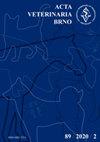Sampling methods for determination of cortisol in pig saliva and their use in the assessment of pig welfare
IF 0.7
4区 农林科学
Q3 VETERINARY SCIENCES
引用次数: 0
Abstract
This study focused on finding new information regarding the assessment of pig saliva cortisol samples in terms of practical effects of the sampling, sample storage conditions, and their laboratory analysis. The study was divided into two experiments. The first experiment was focused on finding the effect of sampling time on cortisol concentrations in pig saliva. The second experiment was focused on determining the effect of storage conditions on the value of salivary cortisol. Before the initiation of the study, we tested which one of the commercially available ELISA kits would be the most suitable for our experiments. Simultaneously, we carried out a pre-study to evaluate the effect of relocation and change in the housing type on the concentration of salivary cortisol in gestating sows. The samples were obtained by oral cavity swabbing, using a standard cotton swab. In the first study, piglets were examined at the age of 4 ± 1 days, and breeding management routine procedures were used as a stress factor. In the second study, the piglets were examined immediately after weaning (at 28 ± 2 days of age). The Cortisol EIA kit was found to be statistically more accurate and thus a more suitable ELISA kit for our experiment. Analysis of the relocation effect and the effect of change in the housing type showed that relocation does not seem to be a stress factor for gestating sows as no significant changes were observed in salivary cortisol concentration (P > 0.5); however, the change in the housing type lead to a significant increase in salivary cortisol (P < 0.001). In the first study, we determined using the ELISA method that the most significant difference occurred in 40 min (P < 0.01), which suggests that the best time for a sampling in order to assess salivary cortisol concentration is 40 min after stress induction by routine procedures. The conclusion of the second study was that in the monitored period of 60 h (P < 0.05), cortisol concentration decreased depending on the storage temperature. The decrease started between 48 and 60 h which showed that cortisol is stable in the saliva sample for at least 48 h. These findings will be further applied in our following studies focused on assessment of salivary cortisol concentration after stress induction.猪唾液中皮质醇测定的取样方法及其在猪福利评估中的应用
本研究的重点是寻找关于猪唾液皮质醇样本在采样、样本储存条件和实验室分析方面的实际效果评估的新信息。这项研究分为两个实验。第一个实验的重点是发现采样时间对猪唾液中皮质醇浓度的影响。第二个实验的重点是确定储存条件对唾液皮质醇值的影响。在研究开始之前,我们测试了哪种市售ELISA试剂盒最适合我们的实验。同时,我们进行了一项预研究,以评估重新安置和住房类型的变化对妊娠母猪唾液皮质醇浓度的影响。使用标准棉签进行口腔拭子取样。在第一项研究中,仔猪在4±1日龄时接受检查,以饲养管理常规程序为应激因素。在第二项研究中,仔猪在断奶后(28±2日龄)立即进行检查。皮质醇EIA试剂盒在统计上更准确,因此是更适合我们实验的ELISA试剂盒。对迁移效应和舍型变化效应的分析表明,迁移似乎不是妊娠母猪的应激因素,因为唾液皮质醇浓度没有显著变化(P > 0.5);然而,壳体类型的改变导致唾液皮质醇显著增加(P < 0.001)。在第一项研究中,我们使用ELISA方法确定,最显著的差异发生在40分钟(P < 0.01),这表明,为了评估唾液皮质醇浓度,采样的最佳时间是常规程序应激诱导后40分钟。第二项研究的结论是,在60 h的监测期内(P < 0.05),皮质醇浓度随储存温度的升高而降低。在48到60小时之间开始下降,这表明皮质醇在唾液样本中至少在48小时内是稳定的。这些发现将进一步应用于我们接下来的研究,重点是评估应激诱导后唾液皮质醇浓度。
本文章由计算机程序翻译,如有差异,请以英文原文为准。
求助全文
约1分钟内获得全文
求助全文
来源期刊

Acta Veterinaria Brno
农林科学-兽医学
CiteScore
1.00
自引率
33.30%
发文量
36
审稿时长
18-36 weeks
期刊介绍:
ACTA VETERINARIA BRNO is a scientific journal of the University of Veterinary and Pharmaceutical Sciences in Brno, Czech Republic.
The scientific journal Acta Veterinaria Brno is dedicated to the publication of original research findings and clinical observations in veterinary and biomedical sciences. Original scientific research articles reporting new and substantial contribution to veterinary science and original methods that have not been submitted for publication elsewhere are considered for publication. A written statement to this effect should accompany the manuscript, along with approval for publication by the author´s head of department. The authors bear full responsibility for the contents of their contribution. Book reviews are published, too.
 求助内容:
求助内容: 应助结果提醒方式:
应助结果提醒方式:


